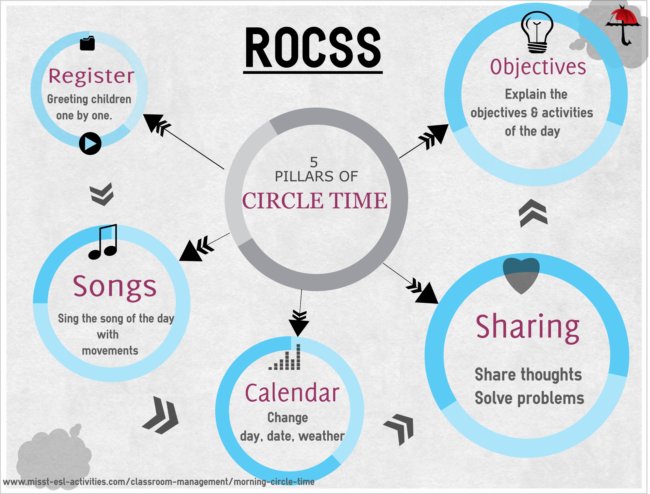Share the image on your site:
I can't emphasize enough how important is to start the day with a routine that our students know and accept.
It also prepares them for the class. For some it might sound unimportant or waste of time but believe me, it is. It has huge benefits in the long term. During circle time or carpet time we can help children to learn some social skills, solving problems, talk about themselves, listen to the others and taking turns, as well.
1. Register
Every morning the teacher gathers around the children in a circle on the carpet to greet them. We start our day by calling out the register saying good morning to every child and asking them how they are that morning.
2. Sharing
If somebody wants to share anything important with the teacher or their peers this is the secured time for it. Children have the chance to talk about whatever they are happy about or whatever bothers them in that particular morning. Their friends can join in the conversation if they have anything to say about the topic, giving advice to one another or trying to solve the problem they have. It is a bit like family time.
We know amazingly lot of things about the life of everybody in the class. (Eg. Luis might be grumpy today because his little brother was teething last night and kept him awake by crying a lot. So we have to help Luis to get through the day and try not to make him angry about anything.) It has a great importance to get these things out of their system so later they could concentrate much better on the subject we learn about.
It is a valued time for each of them and in fact some particular children can't wait to have their turn. It is very hard for them to keep their thoughts in, even for the little time when somebody else is talking. Just imagine if they had no chance to say it out loud all day. Of course, it takes a lot of energy and great effort to behave immaculately, be quiet and listen when you have something important to say. Children have to clear their thoughts and get ready to the new information of the school-day. So this is the first thing we really have to do.
3. Calendar

We have a Calendar and Weather chart on display where we change the days of the week (Monday, Tuesday, Wednesday, Thursday, Friday). It has at least two benefits. First of all, children unconsciously learn about the correct spelling of the days and they have an idea about yesterday and tomorrow, as well. Then the date comes (day and month). We also update the weather (sunny, windy, rainy, cloudy, snowy or stormy) and the seasons (Spring, Summer, Autumn or Winter) once in a while.
4. Song

This is most probably when we sing The Days of the Week or The Weather Song. But it could be any other song as well that matches the day, maybe the season, the weather, somebody's birthday or any other special occasion and of course, whatever topic we are on. Most children like songs, so singing is the part of our routine. Needless to say, whatever we choose to sing, is an action song with some movements.
Any teachers, with young kids in their class, would find that implying movements into the daily routine is quite necessary and most recommended. It activates the brain so kids start their day with more enthusiasm.
5. Objectives
Finally, the teacher tells them what is going to happen that day. What they are learning about, what subjects to have today, what activities to complete and whether they have to do them in groups, in pairs or individually. During explanation, it is also recommended to write the activities at the corner of the blackboard. So later children can see what they have completed and what they still need to accomplish. Whenever the class have finished an exercise the monitor of the day has the responsibility to tick it off the list. It works well even with older kids and saves a lot of unwanted questions such as “And what are we going to do now?” or “When are we going to do this and this?”
You will find it much easier to handle even the difficult children if they can get prepared for everything in advance. If they know exactly how long they have to focus on some 'not so fancy' exercises before doing something promising next, you won't lose their attention. They want to complete every given task. For them having something written on the board is like being carved in stone, it's a MUST. No complains, no “why do we have to do this?” Kids seem to accept easier the parts that they don't like so much if it is explained them in advance and written somewhere they can check it. Ticking it off the list satisfies them more than almost any other things.
When children know about the day ahead, you can start.
It takes everybody some time and effort to get used to any routine. Eventually your hard work will pay off. Following these five steps will help you through the day.
This is the way, we begin our mornings but there is always a space to grow for everybody. Please, share your thoughts below, how you start a school-day?

